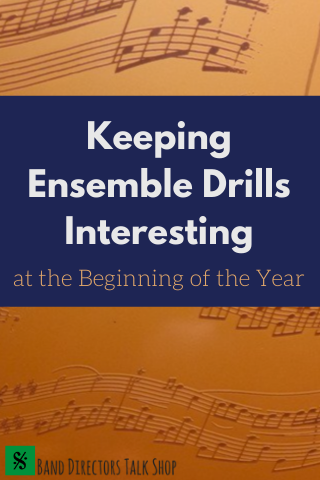It’s finally here. After a summer full of hot days, family vacations, Minecraft and Fortnite, our students will come bounding happily into our band halls, many of them fresh out of beginning classes and excited to experience concert band for the first time. Their enthusiasm for new music and new challenges will be almost palatable, their eyes shining bright, their eager young minds ready to be engaged, and then…many of them will experience that possible killer of joy, that potential vampire of musical energy…the daily drill.
Let me pause here to say that I am completely in favor of (and strongly advocate) a daily routine of fundamentals that both develops ensemble skills and focuses young minds (and ears!). Because we directors recognize the value of the daily drill, it can be easy, especially at the beginning of the year, to get so consumed with it that we lose sight of why our kids enrolled in band in the first place. Although these reasons can vary from student to student (love of music, to be with their friends, band was the lesser of all evils on the electives choice list, whatever), it is highly unlikely that any of them enrolled in band to pursue the perfect Concert F.
Here are a few suggestions for building in the daily drill and ensemble skills at the beginning of the school year without driving your students (and yourself) crazy.

Start Small
There is a lot of great information and a wealth of exercises out there regarding ensemble skills development and the daily drill. From numerous full-length books to any number of clinic hand-outs and exercises available online, a director can find many ideas for what to incorporate into their daily routine. Just remember that it does not all have to be put in place at once.
Long tone exercises that focus on the ability to start, sustain, and release a sound are a great place to start. Such exercises can be very repetitive, though, and the director will likely have to “build up” the students’ stamina when it comes to attention span. It’s suggested that we focus on improving the skill each day with a few minutes of attention rather than hammer it for an extended period.
Remington or other interval type exercises are also an important and popular component of a daily drill. Rather than introduce all of a Remington-type exercise at once, consider introducing just the first few “sets” and then adding a set or two each day or as students improve.
Vary The Types of Exercises
Again, while long tone exercises are key for the development of individual and ensemble playing skills, if it’s all you do for the bulk of a class period, you are going to rapidly come to a point of diminishing returns. Exercise/drill can be varied with articulation exercises, flexibility (lip slurs or flow studies), technical development, rhythm studies, and more.
At first, it is probably most helpful to do the same exercises each day, but as students improve and more exercises are introduced, changing the routine or coming up with an alternating schedule where exercises are still touched upon 2-3 days per week can help keep things fresh.
Know The Goals
Having students understand the goals behind each exercise and receiving understandable, positive feedback as they work toward these goals can increase student buy-in during the portion of class that is devoted to ensemble skill development.
The fastest way to get students to turn off and tune out is to just have them mindlessly play through an exercise or set of exercises each day with no feedback or interaction from the director.
Shake It Up
Hearing individuals and small groups, asking questions, and letting a student or section serve as the example which is then followed by the rest of the ensemble, are ways to maintain a high level of student engagement while still working toward large-group goals.
Use Your Music
Finally, look for opportunities in your performance music to teach and reinforce fundamentals. When possible, tie aspects of the music back to your daily drill (“This part is basically a flow study on steroids.”, “This section uses the same style as the articulation study we introduced yesterday.”, etc.). This helps students see the relevance of the daily drill.
Try to find places where you can work fundamentals through your performance music. Maybe a particular section of a piece works well as a style or articulation drill if you play it on Concert F. Perhaps a lyrical section can be used to teach or reinforce some of the same concepts as a long tone exercise. An upper woodwind passage that makes use of a scale could be written out for the entire band to play together. Not only are you killing two birds with one stone by taking advantage of such opportunities, you are also working on fundamentals in a way that may be more engaging and seem more beneficial to your students. (I liken it to hiding medicine in something that tastes good.)
Again, the establishment of a daily drill or routine of individual playing and ensemble skill development is of high importance and extremely beneficial to any band, regardless of age or ability level. How we go about doing this, especially with younger groups, can have a huge impact on the start of the year.
Jim Shaw is the Director of Bands at Willow Wood Junior High School in Tomball, Texas. A graduate of West Texas A&M University and contributing editor to The Instrumentalist, he can be reached at jshaw322@gmail.com.
Related Reading:
Implementing Change in Your Program
Proactive Classroom Management – The Beginning of the Year
8 Ways to Get More from Your Private Lesson Staff this Year
If you would like to receive our weekly newsletter, sign up here.
Don’t forget to like us on Facebook too!
Learn. Share. Inspire.
BandDirectorsTalkShop.com






Leave a Reply
You must be logged in to post a comment.